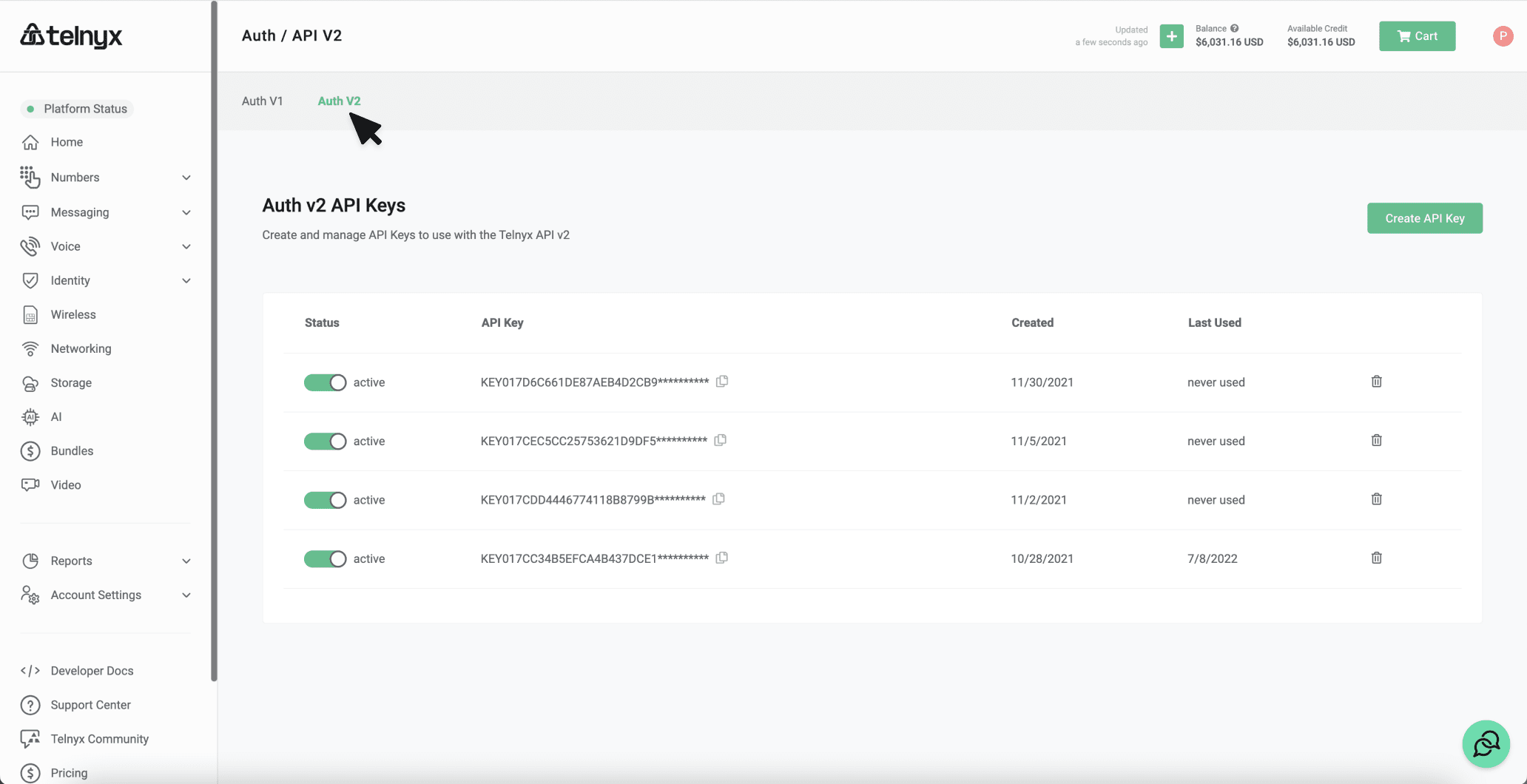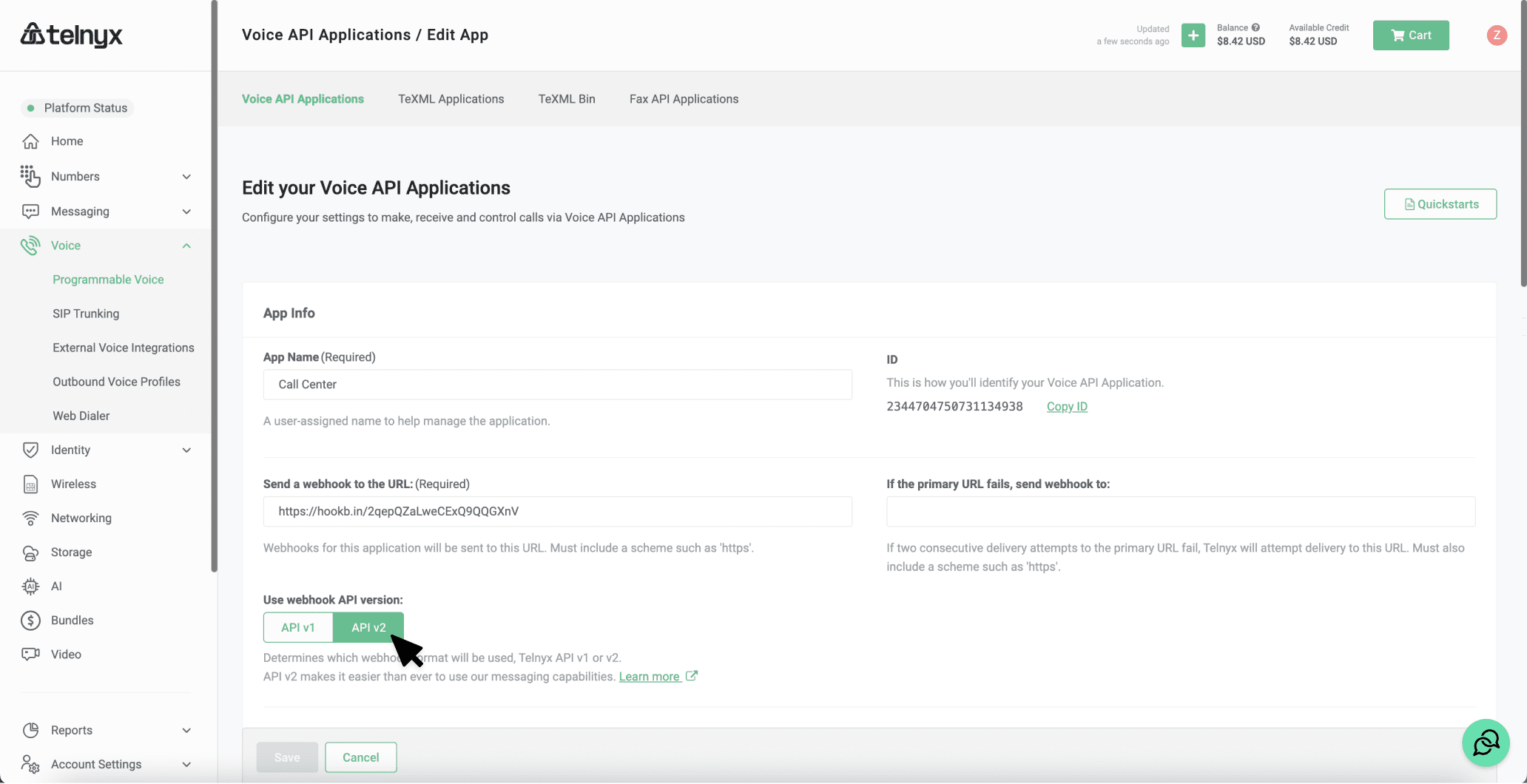Call Control migration to Voice API
Call Control in v1 is now known as Voice API in v2 and has been designed to make migration smooth. This guide highlights the main changes to be aware of when migrating your Call Control application from API v1 to Voice API v2.
Voice API v2 offers the same great call experience but with some changes aimed at making it even easier to have granular-level control over your calls. For new Telnyx users, SDKs available in multiple languages and the introduction of TeXML enable you to get started in minutes. For users with an existing API v1 application, we’ll cover the main changes you should make to migrate to our latest API version.
There are three main areas that require minor changes:
- API v2 Authentication
- Webhook Structure and Signature Validation
- Endpoints for Commands
1. API v2 authentication for voice API
Voice API v2 utilizes a different authentication strategy that will require you to generate a new API key for your Voice application. You can do that easily via the Telnyx Mission Control Portal.
Once you have logged into your Mission Control Portal account, in the left navigation click “Auth”. Then, ensure that Auth v2 is selected in the horizontal navigation.

Click “Create Key”. You will be presented with a pop-up reminding you to store your new API key securely. Click “Create” to confirm. You will then be presented with your new v2 key. You will not be able to see the full key again after this point.
Once a key has been successfully created, you can disable or delete it easily from the main Auth v2 page. Information on creation and recent usage of each key is also available.
2. Webhook structure and signature validation for voice API
Next, let’s compare the webhook response for when a call is answered in both API v1 and v2 so that we can see the differences:
API v1:
{
"record_type": "event",
"id": "0ccc7b54-4df3-4bca-a65a-3da1ecc777f0",
"event_type": "call_answered",
"created_at": "2018-02-02T22:25:27.521992Z",
"payload": {
"call_control_id": "AgDIxmoRX6QMuaIj_uXRXnPAXP0QlNfXczRrZvZakpWxBlpw48KyZQ==",
"to": "+18005550199",
"from": "+35319605860",
"connection_id": "7267xxxxxxxxxxxxxx",
"call_leg_id": "428c31b6-7af4-4bcb-b7f5-5013ef9657c1",
"call_session_id": "428c31b6-abf3-3bc1-b7f4-5013ef9657c1",
"client_state": "aGF2ZSBhIG5pY2UgZGF5ID1d",
"state": "answered",
"occurred_at": "2018-02-02T22:25:27.521992Z"
}
}
API v2:
{
"data": {
"record_type": "event",
"id": "0ccc7b54-4df3-4bca-a65a-3da1ecc777f0",
"event_type": "call.answered",
"occurred_at": "2018-02-02T22:25:27.521992Z",
"payload": {
"call_control_id": "AgDIxmoRX6QMuaIj_uXRXnPAXP0QlNfX",
"to": "+18005550199",
"from": "+18005550100",
"connection_id": "7267xxxxxxxxxxxxxx",
"call_leg_id": "428c31b6-7af4-4bcb-b7f5-5013ef9657c1",
"call_session_id": "428c31b6-abf3-3bc1-b7f4-5013ef9657c1",
"client_state": "aGF2ZSBhIG5pY2UgZGF5ID1d",
"state": "answered"
}
}
}
Note: After pasting the above content, Kindly check and remove any new line added
Data object
Firstly, you will notice that the structure of the payload has changed. There is a top-level data object that contains all subsequent information about the webhook. You will also notice that the top level created_at field in API v1 has been renamed occurred_at - this is the time that the event occurred.
Event type naming convention
The naming convention of the event_type field has also changed for API v2. While the field names remain in snake_case, for event_type the call event being described will be in dot.case for all call events. Events can contain multiple dots to indicate a relationship.
For example, in API v1 when initiating text-to-speech, if the command is successful, your application will receive a webhook containing "event_type":"speak_started". In API v2, your application would receive "event_type": "call.speak.started" for this call event.
Enabling API v2 Webhooks
API v2 webhook structures are not enabled by default. To begin receiving webhooks in the new format, you will need to update your Call Control Application settings for any application you wish to migrate to API v2.

Webhook signatures
Each messaging webhook event that we send you will include a Telnyx signature. The signature allows you to validate that webhooks were not sent by a third-party.
While API v1 uses an HMAC with the SHA256 hash function to sign webhooks, API v2 uses the EdDSA digital signature scheme with a public key.
In API v1, webhooks can be validated using information in the X-Telnyx-Signature header and the raw request payload of the webhook in bytes.
Webhook signing in API V2 uses public key encryption. Telnyx stores a public-private key pair and uses the private key to sign the payload. The public key is available to you so that you can verify the request.
Your public key can be viewed in the Mission Control Portal.
The signature for the payload is calculated by building a string that is the combination of the timestamp of when the request was initiated, the pipe | character and the JSON payload. The signature is then Base64 encoded.
Base64.encode64("#{timestamp}|#{payload}")
Note: After pasting the above content, Kindly check and remove any new line added
The signature (Base64 encoded) and the timestamp (in Unix format) are assigned to the request headers telnyx-signature-ed25519 and telnyx-timestamp respectively.
You can then use cryptographic libraries in your language of choice to verify the signature using the public key. For examples, please see:
3. Endpoints for commands (call control)
API v2 commands have different endpoints to API v1 commands. The base URL for API v2 is https://api.telnyx.com/v2/
The commands carry out the same functions, just at a different URL.
To answer a call in API v1:
https://api.telnyx.com/calls/{call_control_id}/actions/answer
To answer a call in API v2:
https://api.telnyx.com/v2/calls/{call_control_id}/actions/answer
For further reading, you can view the Call Control API Reference here and quickstart guide here.